Leather-Back Sea Turtle - extinction is nearing..
The Leather Back Sea Turtle is the largest out of all the living Turtles that swims with grace in our oceans it is fourth largest behind that of the Crocodilians of which has a life span of on hundred to one hundred and fifty years or more although man is (has) decreased this to (45-50) there are not many of these 100 year olds in our oceans now due to this interference.
The Leather Back or Dermochelys coriacea as it is better known in the maritime world is critically endangered and facing mass global extinction unless humans acknowledge the importance of this gentle giant that gracefully swims thousands of miles in its entire life span.
Living in the Atlantic, Pacific, South China, North American, and Indian oceans the Leather Back Sea Turtle was left untouched like many great ocean giants. Sadly though this affectionate reptilian is in danger of soon becoming one of the next great and splendid wonders of the modern earth to vanish due to poaching, over fishing, from being caught in trawler nets, pollution, habitat destruction from which it cannot lay its young in the desired spots it used to as of housing and other construction sites desecrating their natural birth grounds to human interference.
International Animal Rescue Foundation is surprised that they are still extant, and this is only due to awareness, funding and great marine and land conservation efforts that have kept them so far from extinction. The Leather Back lives as far north to Alaska to the south of Africa and of the tip of New Zealand, to being found in tropical, sub-tropical and even artic oceans, their predators of which some scientists have documented on are the Tiger Shark, Galeocerdo cuvier and the Killer Whales Orcinus orca, more commonly known as the Orca Whale or just Orca which both fine marine specimens are listed as of “least concern” of the I.U.C.N list for now, unlike the Leather Back Sea Turtle.
The Leather Back Turtle has a bigger threat though. The human race and the plastic bag which is littering the oceans everyday suffocating and killing these precious and sensitive reptiles, the beer keg holder (pic below) to is another fatal killer that becomes entwined around the offspring and adolescent Turtles from which the Turtles swim the oceans with these beer keg holders attached growing in to them which then kills the Turtle from strangulation and suffocation or dis-figures the Turtle causing immense suffering and pain.
Picture above is what your beer rings are causing to our diverse species of marine life. PLEASE BIN IT
Pic above shows that of a Turtle suffocating to death on a plastic shopping bag blown out to sea of which they think it is their prey the Jelly Fish. Please view the picture below. If you have a bag, RE-USE IT or BIN IT to be recycled. If you see refuse on any beach PICK IT UP, AND BIN IT or call the environmental services. For more information or should you find a Turtle or any other marine life in this condition and cannot contact or enforce the environmental services to take action then please contact us at the e-mail below.
info@international-animalrescue-foundation.org.uk please leave us a picture or mobile up-load and we will will get back to you within the hour.
Pic above shows what a Turtle would see, they cannot tell the difference. DON’T RUIN WHAT WE ARE LOSING, BAG IT, BIN IT, OR RE-USE IT.
It has been estimated that a total of nineteen million plastic carrier bags are littering our oceans that take a staggering one hundred years to degrade, and cause massive environmental destruction that Mr Geoffrey Davis should have thought more of before developing the bag in 1961. Plastic bags contribute to 20% of all packaging used today that is a number one land and marine animal destructor and an enormous contributor to land fill sites to date.
In regards to the human race, people around the world are still, harvesting Sea Turtle eggs mostly that though off the Leather Back Sea Turtle eggs due to its high demanding market status. Asia is the number one predator that believes like the Rhinoceros horn that Turtle eggs are an aphrodisiac (sexual aid). (Please view pic below). Costa Rica 1-1000 will only live.
Sea-Turtle eggs being poached by Costa Ricans. They are then sold on to the black market for food of which they are eaten to increase sexual dysfunction. Sold mainly to China this is one of the vast killers of our Leather Back Turtles. It has sadly been made “legal” in Costa Rica although the laws are not fully clear here. on approaching CITES it was stated that this is a criminal act and should they be sent to China via export then this country which is one the most corrupt for marine slayings should then be held accountable with sanctions imposed and persons arrested for mass environmental genocide.
(Pic above) Mother Turtles coming in-land to bury their young in Cosa Rica
Full post on this massacre can be viewed here http://coastalcare.org/2011/07/legalized-poaching-turtles-eggs-and-playa-ostional-costa-rica/
In Malaysia they are known to be “extinct” locally. The Caribbean such as Jamaica, Costa Rica, Barbados plus surrounding neighbouring Islands the Leather Back Sea Turtle suffers an agonising and most barbaric loss of its future generations that many local organisations are not taking seriously in these areas that are of high importance and significant environmental value that one could be losing due to greed and counterfeit, make medicines. http://www.soshiok.com/article/10750 (Turtle eggs sold openly in Malaysia even though this is classed as ILLEGAL) Pic below.
Pic above is of Turtle eggs ready to be sold in Asia
Recently in 2011 it was noted in Costa Rica a whole entire birthing area was destroyed along with the eggs removed from sands. Eggs where dug up then sold on to Asian markets, the scene that I can only describe was the most distressing, illegal and organised criminal activity that will most likely go on again this year and next as of the Turtle not knowing any better from which to lay her precious and most critically endangered young. The young of the Leather Back suffer a catastrophic loss though not just from the Human, but also small prey on the land to birds, crustaceans, and opportunist mammals that will either wait for the mother to give birth or sniff out a nest wiping out hundreds of eggs plus years of generations that could keep these nearing extinction reptilians from certain global annihilation.
The Leather Back is listed on the CITES list under annex I that forbids anyone from exporting, importing or using these Turtles in the “highly illegal” animal trade, fishing, or other. Asia though does not care, and although INTERPOL documents and investigates on this mass reptilian and other animal genocide it is always difficult to arrest offenders.
http://www.cites.org/eng/results.php?cites=leather+back+turtles+
International Animal Rescue Foundation though has seen enough now of this marine loss and slaughter and will be working in many alternative ways to aid prosecution of seen and known offenders and opportunists to investigating and documenting markets that are in Asia, and known illegal fishing and animal trade continents that will publish all reports to Interpol and environmental crimes division. We are highly aware of the different conservation laws in many other nations however the fact stands at this. If your caught, you will be subjected to investigation and a full report sent to Interpol along with CITES.
BRIEF HISTORY ON THE LEATHER BACK TURTLE
The first Leather Back Turtles date back to an amazing one hundred million years ago to the Cretaceous period making them “one” of the oldest living reptilians that swim in our oceans to-date.
The male Turtles never leave the water but the female will come in to land to lay her young on average of one to two hours. The female can nest up to ten times in one season and will continue to return to that nesting spot for up to thirty years. (This is where good conservation practice along with local policing and governmental agencies now need to take action to secure these most sensitive areas).
Due to inland and marine pollution, predators, poaching and human overpopulation it has been estimated that one out of only one thousand hatchlings will actually make it to maturity. Although Costa Rica has an appalling and destructive poaching and illegal animal trade it still remains one of the many but few countries that scientists will travel to, to view and study the Leather Back Sea Turtle.
Studies have proven that the temperature of a Leather Backs nest of which she builds most gracefully and beautifully determines whether the hatchlings will be mostly male or female, that may give some indication as to why Costa Rica is one of the largest areas of which the Leather Back Sea Turtle lays its eggs in deep sand, and the high poaching rate. Costa Rica now needs to address this issue and with haste before the entire South American rim is wiped clean of these most stunning, sensitive and graceful reptilian giants of the oceans. Pictured below is the map of the nesting grounds from which mother and not male will come to ground up to 30 times in one nesting season. Parque Nacional Las Baulas is situated just of the coast of Costa Rica and is a hot spot but most sacred ground for the Leather Back Sea Turtle and other species of diverse nature and flora.
The Leather Back Sea Turtle has many characteristics that you can easily identify from other Turtles. Please do note these down if you are planning on visiting the islands just of Costa Rica or Costa Rica itself.
The Leather Back has the most hydrodynamic body of any other sea Turtle meaning in theory that it can travel very easily and quickly through water without much if not any drag on its subtle but strong structural shell (body). Its most noticeable feature is its lack of bony feature or (caraplace).
Leather Backs do not have scutes but more thick leathery skin with embedded miniscule with embedded osteoderms, (osteoderms are bony “deposits that form scales”). Leather Backs have seven unique and distinct ridges that rise from the caraplace, crossing from the anterior to posterior margin of the turtle’s back.
Although the Leather Back is of the reptilian family, they are the ONLY turtle that’s scales do NOT contain Keratin of which is the same structural material found in human bone and nails, hoof, horn and cockatiel beaks. Their lower surface near the dorsal is coloured dark grey to black with some faint blotches, not all of the coriacea though are identical in blotching’s or colourings.
The Leather Back Sea Turtle has points instead of teeth like that of the fresh water Turtle the Snapper. These kings of the sea dine on Jelly Fish and the occassional squid, its backward points or (spines) in it’s mouth help it to swallow food more easily. One will mostly view Leather Back Turtles in the evening at sun fall in more shallow waters from which they will carry on following their prey (Jelly Fish) in deeper waters also keeping a low profile from other predators in the morning to mid day.
http://icyvirgorox.blogspot.co.uk/2012_06_01_archive.html (WARNING) Some imagery you may find upsetting.
Video below depicts how we believe they should be. International Animal Rescue Foundation will be launching a world wide fight to now tackle, make aware, and support through funding this tragic and barbaric marine culture that could see our million year old Turtles wiped out.
Quick Facts (Nationl Geograpic)
Type: Reptile
Diet: Carnivore
Average life span in the wild: 45 years (est.) this is based on poaching and human interference. They are though known and it is has been proven that they can live up to 100-160 years
Size: Up to 7 ft (2 m)
Weight: Up to 2,000 lbs (900 kg)
Protection status: Endangered (Now critical) as listed on the I.U.C.N. list new update.
Did you know?
The largest leatherback ever found was an 8.5-ft-long (2.6-m-long) male weighing 2,020 lbs (916 kg) that washed up on the west coast of Wales in 1988.
Size relative to a 6-ft (2-m) man:
Leatherbacks undertake the longest migrations between breeding and feeding areas of any sea turtle, averaging 3,700 miles (6,000 kilometers) each way. After mating at sea, females come ashore during the breeding season to nest. The nighttime ritual involves excavating a hole in the sand, depositing around 80 eggs, filling the nest, leaving a large, disturbed area of sand that makes detection by predators difficult, and finally returning to the sea.

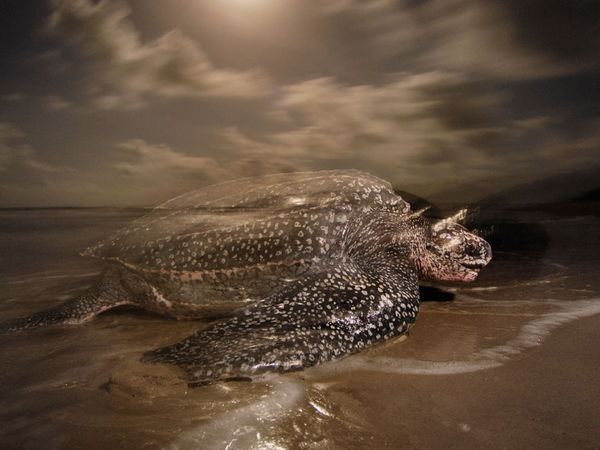
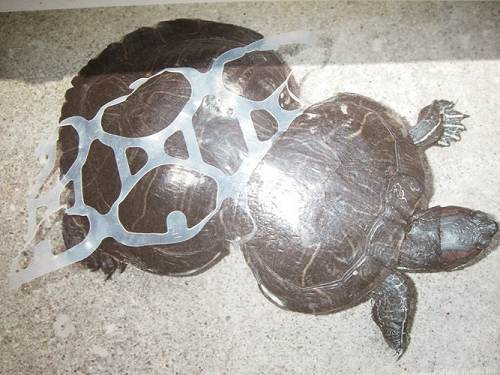
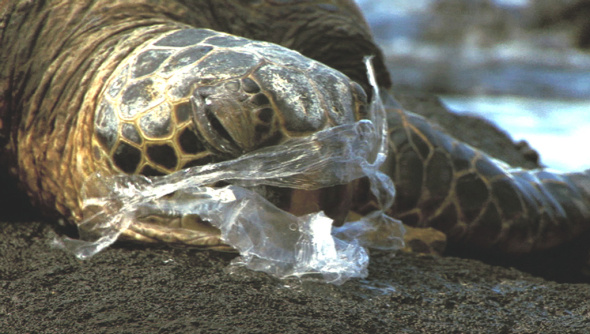

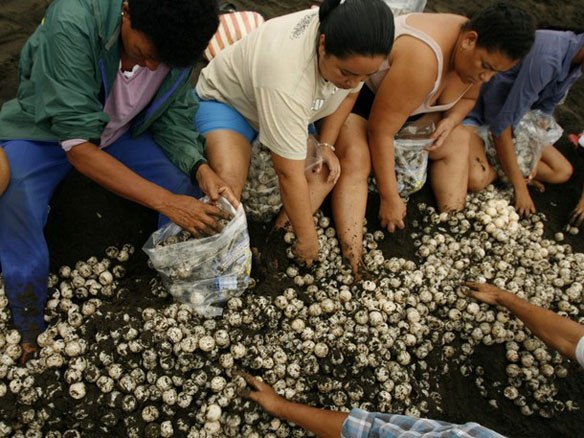

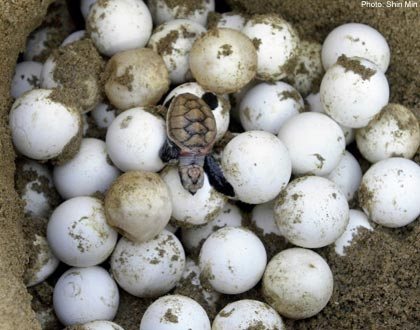



Thank you for your reply, should it merit a response we will respond in due course. This site is owned by International Animal Rescue Foundation and moderation is used.